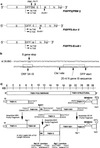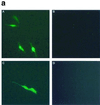Heterologous gene expression from transmissible gastroenteritis virus replicon particles
- PMID: 11773416
- PMCID: PMC135785
- DOI: 10.1128/jvi.76.3.1422-1434.2002
Heterologous gene expression from transmissible gastroenteritis virus replicon particles
Abstract
We have recently isolated a transmissible gastroenteritis virus (TGEV) infectious construct designated TGEV 1000 (B. Yount, K. M. Curtis, and R. S. Baric, J. Virol. 74:10600-10611, 2000). Using this construct, a recombinant TGEV was constructed that replaced open reading frame (ORF) 3A with a heterologous gene encoding green fluorescent protein (GFP). Following transfection of baby hamster kidney (BHK) cells, a recombinant TGEV (TGEV-GFP2) was isolated that replicated efficiently and expressed GFP. Replicon constructs were constructed that lacked either the ORF 3B and E genes or the ORF 3B, E, and M genes [TGEV-Rep(AvrII) and TGEV-Rep(EcoNI), respectively]. As the E and M proteins are essential for TGEV virion budding, these replicon RNAs should replicate but not result in the production of infectious virus. Following cotransfection of BHK cells with the replicon RNAs carrying gfp, GFP expression was evident by fluorescent microscopy and leader-containing transcripts carrying gfp were detected by reverse transcription-PCR (RT-PCR). Subsequent passage of cell culture supernatants onto permissive swine testicular (ST) cells did not result in the virus, GFP expression, or the presence of leader-containing subgenomic transcripts, demonstrating the single-hit nature of the TGEV replicon RNAs. To prepare a packaging system to assemble TGEV replicon particles (TGEV VRP), the TGEV E gene was cloned into a Venezuelan equine encephalitis (VEE) replicon expression vector and VEE replicon particles encoding the TGEV E protein were isolated [VEE-TGEV(E)]. BHK cells were either cotransfected with TGEV-Rep(AvrII) (E gene deletion) and VEE-TGEV(E) RNA transcripts or transfected with TGEV-Rep(AvrII) RNA transcripts and subsequently infected with VEE VRPs carrying the TGEV E gene. In both cases, GFP expression and leader-containing GFP transcripts were detected in transfected cells. Cell culture supernatants, collected approximately 36 h posttransfection, were passed onto fresh ST cells where GFP expression was evident approximately 18 h postinfection. Leader-containing GFP transcripts containing the ORF 3B and E gene deletions were detected by RT-PCR. Recombinant TGEV was not released from these cultures. Under identical conditions, TGEV-GFP2 spread throughout ST cell cultures, expressed GFP, and formed viral plaques. The development of infectious TGEV replicon particles should assist studies of TGEV replication and assembly as well as facilitate the production of novel swine candidate vaccines.
Figures












References
-
- Balasuriya, U. B., H. W. Heidner, J. F. Hedges, J. C. Williams, N. L. Davis, R. E. Johnston, and N. J. MacLachlan. 2000. Expression of the two major envelope proteins of equine arteritis virus as a heterodimer is necessary for induction of neutralizing antibodies in mice immunized with recombinant Venezuelan equine encephalitis virus replicon particles. J. Virol. 74:10623–10630. - PMC - PubMed
-
- Banchereau, J., and R. M. Steinman. 1998. Dendritic cells and the control of immunity. Nature 392:245–252. - PubMed
Publication types
MeSH terms
Substances
Grants and funding
LinkOut - more resources
Full Text Sources
Other Literature Sources
Research Materials

